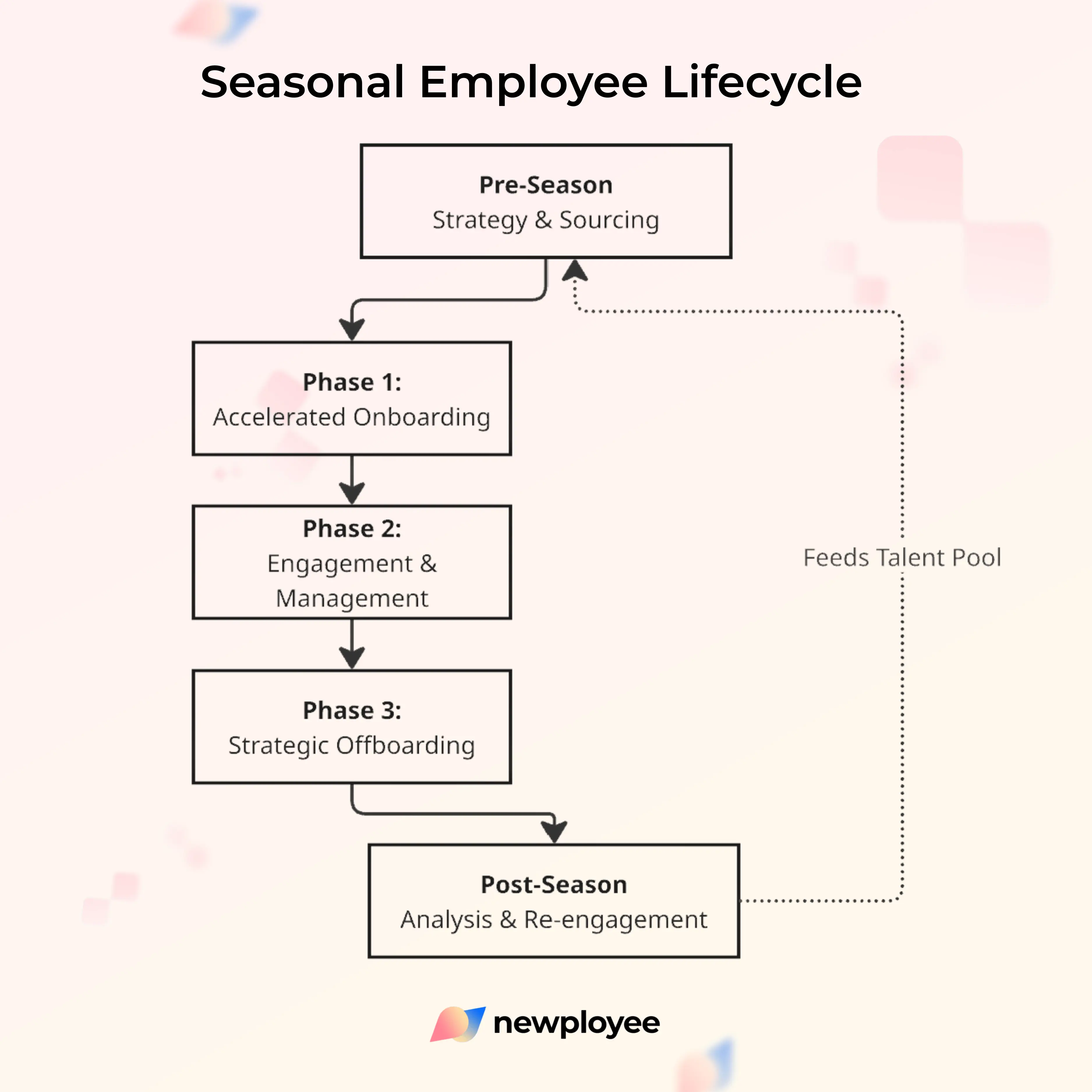Seasonal unemployment is a structural reality of the global economy, presenting a critical test of operational agility for Human Resources.
While economists view it as a statistical factor to be adjusted for, HR leaders live its consequences: the relentless, predictable cycles of mass hiring, rapid training, intensive management, and structured offboarding.
Mastering this cycle is not merely an administrative task, it is a strategic imperative that directly impacts customer satisfaction, employer brand, operational efficiency, and profitability.
This guide provides a deep-dive framework to transform seasonal employment from a perennial struggle into a demonstrable source of competitive strength.
1. Deconstructing Seasonal Unemployment
Core Definition: Seasonal unemployment occurs when individuals are without work during specific periods of the year due to predictable fluctuations in demand or supply inherent to their industry.
Key Differentiators from Other Unemployment Types:
- Predictable & Cyclical: Unlike cyclical unemployment (caused by economic recessions) or structural unemployment (caused by a skills mismatch), seasonal unemployment follows a reliable, calendar-based pattern. This predictability is its primary challenge and its greatest strategic opportunity.
- Temporary by Design: Employment is intended to be short-term, with a pre-defined or clearly understood end date.
- Industry-Concentrated: It is heavily prevalent in sectors influenced by weather, holidays, and natural growing cycles.
The HR Lens: For HR, seasonal unemployment is an internal process challenge. It encompasses the entire lifecycle of managing a transient workforce: the cost, logistics, and strategy of hiring, onboarding, engaging, and offboarding employees at scale, under tight time constraints.
2. The Seasonal Landscape: An Industry Breakdown
The table below illustrates the varying faces of seasonal employment across key sectors:
3. Mastering the Seasonal Employee Lifecycle
Effective management requires a proactive, phase-based approach. The following lifecycle model ensures no critical step is missed:

Phase 1: Pre-Season Strategy & Sourcing (The Foundation)
- Forecasting & Planning: Use historical data to predict headcount needs with 90%+ accuracy. Collaborate closely with Operations and Finance.
- Building the Talent Pipeline:
- Rehire Pool: Proactively contact top performers from previous seasons.
- Employee Referral Programs: Leverage your permanent staff's networks for qualified candidates.
- Community Partnerships: Partner with universities, vocational schools, and retiree associations.
- Crafting Compelling Job Descriptions: Be transparent about the temporary nature while selling the experience, benefits, and potential for rehire.
Phase 2: Accelerated & Effective Onboarding
The goal is "Day One Productivity." A disorganized first day can reduce a new hire's commitment by over 30%.
- Digital-First Onboarding: Utilize an HRIS or onboarding platform (e.g., BambooHR, Workday) to automate paperwork, policy sign-offs, and training modules. This saves dozens of administrative hours.
- The "Fast-Track" Onboarding Kit:
- Checklist: A digital checklist for managers ensures consistency.
- Micro-Learning Modules: Bite-sized videos on critical topics: safety, the point-of-sale system, and handling the top 3 customer queries.
- "Who's Who" Guide: Photos and roles of key team members.
- Cultural Immersion from Hour One:
- Include seasonal staff in all-team meetings.
- A welcome speech from a senior leader emphasizing their value.
- The Buddy System: Pair each new hire with a vetted, high-performing permanent employee. This speeds up integration and reduces the manager's burden.
Phase 3: Engagement & Performance Management
Short-term does not mean low-priority. Disengagement is contagious and costly.
- Set Clear, Short-Term Goals: Use daily or weekly targets for sales, customer satisfaction, or productivity.
- Provide Real-Time Feedback: Managers should give "in-the-moment" coaching, not wait for a final review.
- Recognize and Reward: Implement simple, low-cost programs: "Employee of the Week," spot bonuses, or public recognition in team chats.
- Measure Sentiment with Pulse Surveys: Use short, anonymous surveys (e.g., via SurveyMonkey or Culture Amp) to gauge morale and identify issues before they escalate.
Phase 4: Strategic Offboarding (The Beginning of the Next Cycle)
This is not an end, but a critical investment in future seasons.
- Structured Exit Interviews: Ask specific questions: "What was the most frustrating part of your training?" "What would make you 100% likely to return?"
- Knowledge Capture: Create a simple form for departing employees to share tips and tricks for the role.
- The Three-Tier Rehire Pool:
- Green Tier (Auto-Rehire): Top performers. Offer them next season's role first.
- Yellow Tier (Conditional Rehire): Solid performers. Contact them early in the next cycle.
- Red Tier (Do Not Rehire): Documented poor performers.
- The Positive Farewell: A sincere thank-you, a branded gift, or a final team lunch. A respectful offboarding experience turns former employees into brand ambassadors.
4. Advanced Strategies and Hybrid Models
- The "Evergreen" Talent Pool: For companies with complementary seasonal peaks (e.g., a parent company with ski resorts and beach hotels), create a year-round workforce that moves between locations. This drastically increases loyalty and reduces hiring costs.
- Gamification for Performance: Introduce friendly competition with leaderboards for key metrics (e.g., units picked, positive customer reviews). Small rewards can drive significant engagement.
- Upskilling for Retention: Offer optional, free micro-courses (e.g., on customer service excellence or time management). This adds value to the role and increases the likelihood of return.
5. The Technology Stack: Automation as a Force Multiplier
Technology is non-negotiable for scaling seasonal workforce management.
- Applicant Tracking System (ATS): Manages high-volume applications, tags candidates, and builds your talent pipeline.
- Onboarding Platforms: Automate the entire pre-boarding and onboarding workflow.
- Performance Management Tools: Use mobile-friendly tools for goal setting and real-time feedback.
- Communication Apps: Platforms like Slack or Microsoft Teams keep seasonal workers integrated and informed.
- Data & Analytics: Track key metrics to drive improvement:
- Time-to-Hire & Cost-per-Hire
- Seasonal Employee Return Rate (The most critical KPI)
- Reason for Not Returning
6. Case Study: "Project Rehire" at a Luxury Resort Chain
- Challenge: A resort group with 20 locations had a meager 25% seasonal staff return rate, leading to high recruitment costs and inconsistent guest service.
- Solution: "Project Rehire" – A multi-faceted initiative:
- Personalized Outreach: Managers personally called top performers from the previous season to gauge interest.
- Streamlined Re-hiring: Returning staff underwent a 50% faster onboarding process.
- "Culture Captain" Program: Selected returning staff were given leadership roles in onboarding new seasonal hires and organizing social events.
- Loyalty Bonus: A structured bonus paid upon successful completion of the season and another upon re-signing for the next year.
- Results: Within two years, the return rate jumped to 60%. Recruitment costs fell by 35%, and guest satisfaction scores rose by 15 points, as experienced staff provided superior service.
7. The Legal and Ethical Framework
- Clear Classification: Ensure all seasonal workers are correctly classified as such, with clear start and end dates in their contracts, in compliance with local labor laws.
- Equity in Treatment: While benefits may differ, the principle of equal treatment for equal work in terms of respect, safe working conditions, and access to facilities is crucial for morale and legal compliance.
- Safety First: Do not cut corners on safety training. A temporary worker is just as vulnerable to injury as a permanent one.
Conclusion: From Seasonal Struggle to Strategic Asset
Seasonal unemployment presents a permanent test of an organization's operational agility and human-centric leadership.
The companies that excel are those that refuse to see their seasonal workforce as a disposable cost center.
Instead, they view them as a vital, recurring asset and a frontline extension of their brand.
By implementing a strategic, technology-enabled, and empathetic approach to the entire seasonal employee lifecycle, from pre-season planning and accelerated onboarding to continuous engagement and strategic offboarding, HR leaders can transform this annual challenge into a powerful driver of customer satisfaction, brand strength, and sustainable growth.
The goal is not just to survive the peak season, but to build a system that thrives because of it.
.webp)





-min.webp)

